Module 4
1. Module 4
1.13. Page 5
Module 4—Magnetic and Electric Fields in Nature and Technology
 Watch and Listen
Watch and Listen
Complete the Force on a Charge tutorial to explore the nature of the magnetic force acting on a charged particle travelling through a magnetic field.
 Module 4: Lesson 2 Assignment
Module 4: Lesson 2 Assignment
Remember to submit the answers to A 3, A 4, A 5, and A 6 to your teacher as part of your Module 4: Lesson 2 Assignment.
A 3. An electron experiences a downward magnetic force of 7.15 × 10–14 N when it is travelling at 3.00 × 105 m/s south through a magnetic field. Calculate the magnitude of the magnetic field and determine its direction using the right-hand rule.
A 4. A charged particle is travelling west through a downward magnetic field and it experiences a magnetic force directed to the north. Using the appropriate hand rule, determine whether the charge is negative or positive.
A 5. Calculate the magnitude and the direction of the magnetic force acting on an alpha particle that is travelling upwards at a speed of 3.00 × 105 m/s through a 0.525-T west magnetic field.
A 6. An electron (m = 9.11 × 10–31 kg) enters a downward magnetic field of 5.00 × 10–1 T with a velocity of 6.50 × 106 m/s West. Calculate the radius of the circular path it will follow once it is travelling within the magnetic field.
 Try This
Try This
TR 2. For extra practice, you may choose to try some of the “Practice Problems” on pages 599−600 of the textbook. If you choose to do a small number of problems, be sure to do question 2 on page 599 and question 2 on page 600.
 Self-Check
Self-Check
SC 6. Calculate the magnitude and direction of the acceleration of a proton (m = 1.67 × 10–27 kg) that is travelling east at a speed of 9.00 × 104 m/s through a magnetic field of 3.00 × 10–1 T that is directed south. See “Practice Problem” 2 on page 600 of the textbook for a hint.
Questions SC 7, SC 8, and SC 9 relate to another experiment about cleaning flue gases from a power plant. A particle present in the flue gas, with a charge of –3.2 × 10–17 C, enters a region with a magnetic field strength of 2.5 × 10–2 T. The magnitude of the particle's velocity was 12.0 m/s. The following diagram illustrates the details. Use this information to answer SC 7 to SC 9.
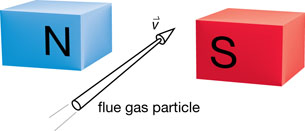
SC 7. Determine the direction of the magnetic force acting on the particle once it enters the magnetic field.
SC 8. In addition to the magnetic force, the force of gravity also acts on the particle. Under the right conditions, the effect of the magnetic force could be balanced by the force of gravity, allowing the particle to pass through the magnetic field undeflected. Draw a free-body diagram to illustrate the forces that would act on the particle in this case.
SC 9. Determine the necessary mass of the flue gas particle in order for it to pass through the magnetic field undeflected. Remember to use the GRASP method for solving problems.
 Self-Check Answers
Self-Check Answers
Contact your teacher if your answers vary significantly from the answers provided here.
SC 6.

Required
The acceleration of the proton.
Analysis and Solution
Find the force acting on the proton.
Fm = qvB
Fm = (1.60 × 10–19 C)(9.00 × 104 m/s)(3.00 × 10–1 T)
Fm = 4.32 × 10–15 N [downwards]
Find the acceleration of the proton.

Paraphrase
The acceleration of the proton is 2.59 × 102 m/s2 [downwards, into the page]
SC 7.
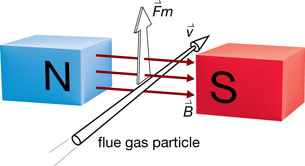
SC 8.
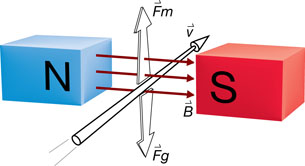
SC 9.
Given
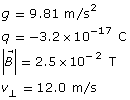
Required
the mass of the flue gas particle, m
Analysis and Solution
The gravitational force acting on the flue gas particle has a magnitude of ![]() and is directed downward. The magetic force acting on the glue gas particle has a magnitude of
and is directed downward. The magetic force acting on the glue gas particle has a magnitude of ![]() and is directed upward.
and is directed upward.
![]()
Since the forces balance, ![]() . Therefore,
. Therefore,

Paraphrase
The mass of the flue gas particle is 9.8 × 10–19 kg.
In 1897 Sir Joseph John Thomson (1856–1940) conducted an original study of cathode rays that resulted in the discovery of the electron. He was awarded the Nobel Prize in 1906 “in recognition of the great merits of his theoretical and experimental investigations on the conduction of electricity by gases.”
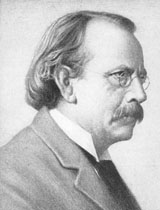
The following quote is taken from his Nobel Lecture on Physics on December 11, 1906:
In this lecture I wish to give an account of some investigations which have led to the conclusion that the carriers of negative electricity are bodies, which I have called corpuscles, having a mass very much smaller than that of the atom of any known element, and are of the same character from whatever source the negative electricity may be derived.
The first place in which corpuscles were detected was a highly exhausted tube through which an electric discharge was passing
.
Nobel Lectures: Physics, 1901–1921 (Amsterdam: Elsevier, 1967)
 Discuss
Discuss
In his lecture Thomson continued to describe a series of experiments he had conducted on cathode rays. In one experiment he subjected the cathode ray to an external magnetic field to verify that the cathode ray consisted of nothing other than a stream of negative charges. Then he verified this in a second experiment where he successfully observed the cathode ray being deflected by an electric field—in a direction consistent with a negative charge. This had not been observed previously, and Thomson correctly assumed that this was due to leftover gases that could not be evacuated from the cathode ray tube due to imperfections in the equipment. Thomson’s equipment was able to achieve a greater vacuum than previous attempts.
In the third experiment Thomson measured the charge-to-mass ratio of the electron (which he described as a corpuscle).
D 1. Research Thomson’s work on the charge-to-mass ratio and answer the following:
-
If both an electric field and a magnetic field exert a force on a moving electron, could they be arranged in such a manner that each force cancels the other out, allowing the electron to pass through a CRT without being deflected? Sketch the orientation of the electric and magnetic fields to show that an electron travelling west could pass through each field simultaneously without being deflected. Label your diagram.
-
In order for an electron to pass through both the electric and magnetic fields without being deflected, the magnetic force (
 ) must be identical in magnitude to the electric force (
) must be identical in magnitude to the electric force ( ). Derive an expression for the velocity of the electron when these two forces are equal to one another.
). Derive an expression for the velocity of the electron when these two forces are equal to one another.
-
If the electric field is turned off, what kind of motion will result from the application of only the magnetic field?
-
If the magnetic force (
 ) is an inward force (
) is an inward force ( ) when acting alone, determine an expression for the charge-to-mass ratio of an electron (q/m) by first equating Fm and Fin.
) when acting alone, determine an expression for the charge-to-mass ratio of an electron (q/m) by first equating Fm and Fin.
-
Why was determining the charge-to-mass ratio of an electron considered important?
D 2. Post your responses to the discussion area for your class. Read the responses of at least two other students.
 Module 4: Lesson 2 Assignment
Module 4: Lesson 2 Assignment
Remember to submit the answers to D 3 to your teacher as part of your Module 4: Lesson 2 Assignment.
D 3. Revise your responses to D 1 and include comments on what you learned from reading other students’ responses.
Discussion Scoring Guide
Principles involved: Thomson’s charge-to-mass ratio experiment |
||||
Criteria |
Level 1 |
Level 2 |
Level 3 |
Level 4 |
Knowledge |
||||
| Demonstrates understanding of the situation, physics principles and technology, and their connections. | Demonstrates a vague and sometimes incorrect understanding of the physics principles involved. Obvious irrelevant or missing information. |
Demonstrates a basic understanding of the physics principles involved. May exhibit minor mistakes or vague information or application to the situation. |
Demonstrates a good understanding of the physics principles involved and applies them properly to the given situation. All necessary information is given. |
Demonstrates a superior understanding of the physics principles involved and their application to the situation. All applications are considered in detail. |
Reflection |
||||
The post shows reflection on one’s own and other students’ work. Contributes to the group discussion. |
Does not make an effort to participate. Seems indifferent to discussion. |
Occasionally makes meaningful reflections on the group’s efforts or discussions. Marginal effort is shown to become involved with the group or discussion. |
Frequently makes meaningful reflections on the group’s efforts and presents relevant viewpoints for consideration by the group. Interacts freely with group members. |
Regularly attempts to motivate the group discussion and delve deeper into concepts. Interacts freely and encourages all group members. |
Content and presentation of discussion summary |
||||
The information is logically arranged in a clear and concise manner. |
The information is poorly organized with many concepts implied. Irrelevant or rambling sentences make reading difficult. |
The information is somewhat organized with implied concepts. Excessive words or awkward sentences are used, which hinder reading. |
The information is well-organized and logically arranged. All concepts are explicitly explained. There are a few awkward but understandable sentences. |
The information is well-organized and very easy to understand. Well-worded sentences make reading pleasurable. |